Colin's Journal: A place for thoughts about politics, software, and daily life.
April 17th, 2005
London Marathon
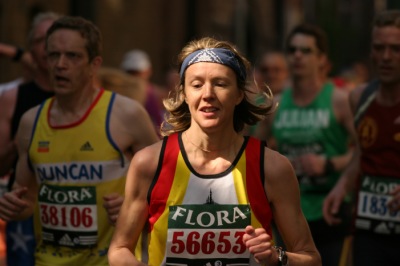 Given that the route of this year’s London Marathon included a stretch down Narrow Street, I could hardly avoid watching for a while. All I had to do was get out of bed in time, which I managed with about fifteen minutes to spare before Paula Radcliffe went hurtling past. The weather couldn’t have been much better for the event, blue skies and a warm sun but still chilly in the shade. Our neighbourhood attracted a fair number of visitors, far more people were taking advantage of the building’s square than I’ve seen before.
Given that the route of this year’s London Marathon included a stretch down Narrow Street, I could hardly avoid watching for a while. All I had to do was get out of bed in time, which I managed with about fifteen minutes to spare before Paula Radcliffe went hurtling past. The weather couldn’t have been much better for the event, blue skies and a warm sun but still chilly in the shade. Our neighbourhood attracted a fair number of visitors, far more people were taking advantage of the building’s square than I’ve seen before.
I took a few photos, but with the crowds of spectators and closely packed runners it was hard to get good shots. The real challenge, however, was my ailing camera batteries. They used to last for long periods of time, at least a full afternoon, and between two of them I could easily spend the whole day taking pictures. For some reason the last few charges haven’t lasted long at all, often failing within an hour of use. I’ve started the process of reconditioning them to see whether I can get more out of them, but if they don’t improve I’ll be forced to buy some replacements.
April 5th, 2005
Borough Market
Two weeks back I visited the Borough Market with Shana and aquitaineq. I should point out that we visited the weekly fine food market, rather than the daily wholesale market that runs throughout the early hours of the morning and finishes around 9am. Getting up early enough to photograph the wholesale market could be rewarding however, so I may try at some point.
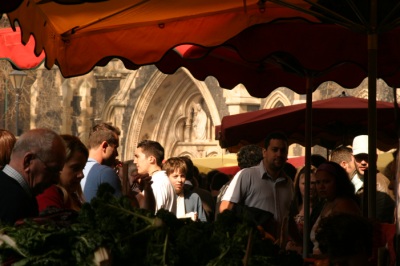 The location of the market creates a peculiar space. The market nestles partly under London Bridge, partly in it’s own buildings, and partly in the open air next to Southwark Cathedral. The result is a scene of many layers, allowing a photographer to combine the grey industrial surroundings, the cheerful market colours and the warmth of the cathedral in many different ways. My attempts to capture a scene with the rail bridge, the market and the cathedral didn’t work out as well as I hoped they would, meriting another trip soon. I did have more luck with some of my other shots, although more attempts could undoubtedly produce better results.
The location of the market creates a peculiar space. The market nestles partly under London Bridge, partly in it’s own buildings, and partly in the open air next to Southwark Cathedral. The result is a scene of many layers, allowing a photographer to combine the grey industrial surroundings, the cheerful market colours and the warmth of the cathedral in many different ways. My attempts to capture a scene with the rail bridge, the market and the cathedral didn’t work out as well as I hoped they would, meriting another trip soon. I did have more luck with some of my other shots, although more attempts could undoubtedly produce better results.
Today brought the formal announcement of the general election on the 5th of May. While the date of the election has been predicted for many months now, the official announcement does usher in two major changes. Firstly TV news now has to cover every obscure political party you’d almost forgotten existed (Greens, that welsh party with the funny name, SNP, UKIP) and more importantly Peter Snow’s swingometer is back on the telly. While I’d like to do my bit to save Britain from ID cards and nasty anti-terrorism legislation, I now live in a constituency so safe for Labour they couldn’t loose it if they actively tried. Instead the best I can hope for from my vote is a pleasant walk to wherever the nearest polling station is.
March 20th, 2005
Wildlife Photographer of the Year
On Saturday we went to see the Wildlife Photographer of the Year 2004 exhibition at The Natural History Museum. The photos themselves are, as you would expect, of a very high standard indeed. While a very small number had faults that I found visually annoying, the rest were of the level of quality that I would love my photos to one day reach.
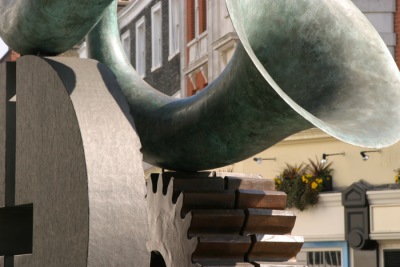 Of the several photos that stuck in my mind I think my favourite is the “Bald eagles in mid-winter” by Klaus Nigge. The image on the competitions website doesn’t do the photo justice of course, but close examination does bring out the feel of the picture. Unlike most of the other entries in the category of Animals in Their Environment, this picture gives the environment the larger visual impact. The combination of snow, blue-grey seas, dark rocks and close horizon bring a real sense of cold and isolation. It’s only after this sense has been set that the birds themselves become interesting.
Of the several photos that stuck in my mind I think my favourite is the “Bald eagles in mid-winter” by Klaus Nigge. The image on the competitions website doesn’t do the photo justice of course, but close examination does bring out the feel of the picture. Unlike most of the other entries in the category of Animals in Their Environment, this picture gives the environment the larger visual impact. The combination of snow, blue-grey seas, dark rocks and close horizon bring a real sense of cold and isolation. It’s only after this sense has been set that the birds themselves become interesting.
One disappointment with the exhibition is the quality of the curating. The room needed to be much larger for the number of pictures that were being shown. Photos were back-lit, an excellent way to show them, but facing one another. As a result you could rarely see the whole photo without the interference of a reflection from the picture on the opposite wall, and some pictures couldn’t be seen at all. In addition one of the light units had failed; staff had enough time to print out a specially labelled apology, but not actually change the light bulb. Finally the room was slightly over heated from the large number of visitors shuffling from picture to picture.
—
The photo is part of a sculpture between South Kensington tube station and The Natural History Museum.
March 14th, 2005
Markup
Shorthand markup languages, which are intended to make writing HTML easier, are very popular. At least they are popular if you measure popularity by the sheer number of them available. Personally I think they are a poor solution to the problem for making the authoring of HTML easy.
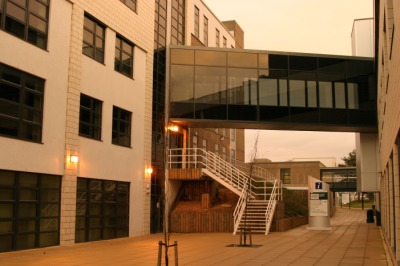 Markup languages are mainly popular because programmers are lazy, and creating a graphical interface for editing HTML is difficult. Web browsers supply a built in “rich text editor” that allows simple HTML to be authored, but the subset of HTML that they provide authoring for, is usually different to the subset that the user would like to use. For example most of the rich text editors let you change the colour of the text, but not the title of a hyper-link.
Markup languages are mainly popular because programmers are lazy, and creating a graphical interface for editing HTML is difficult. Web browsers supply a built in “rich text editor” that allows simple HTML to be authored, but the subset of HTML that they provide authoring for, is usually different to the subset that the user would like to use. For example most of the rich text editors let you change the colour of the text, but not the title of a hyper-link.
I recently stumbled across the Markdown markup language. It seems to strike the right balance between useful facilities (such as automatic escaping of HTML) and obscure hard to remember syntax (such as that used by Textile).
There is an initial Python implementation of Markdown, and I’ve written a plugin for PubTal so I can use it. I don’t think it’s yet ready for real use because the Python Markdown library isn’t finished and has some strange debug code left in. Once the Markdown library is up to quality I’ll probably ship the plugin with PubTal.
On the SimpleTAL front there is an ongoing effort to add I18N support. I’m not entirely sure I like the specification for I18N support in TAL. It seems to be trying to solve too large a problem, and consequently gets it wrong. Unless I can come up with a better workable alternative however, the implementation of I18N is probably the best way of supporting multiple language use in a single SimpleTAL template.
February 23rd, 2005
Trips and pics
Today I booked tickets for a week-long visit to Toronto. It’ll be one of the more peculiar trips I’ve taken; visiting an old home that still houses most of my possessions, a city that I know and friends that I’ve left behind. The trip is scheduled for 22nd April, a good couple of months away yet.
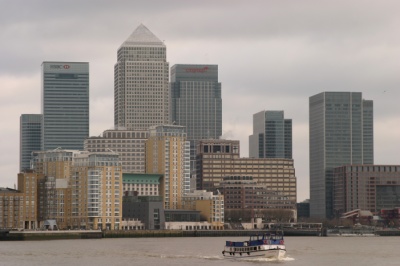 Last weekend was mostly a lazy one. On Friday I met up with Easter Bunny, Aca and Haggis The Second for dinner at a small restaurant called Pierino’s. On Saturday I had intended to get up early and catch the sun, instead I got up late, perfectly timed for the skies to have clouded over.
Last weekend was mostly a lazy one. On Friday I met up with Easter Bunny, Aca and Haggis The Second for dinner at a small restaurant called Pierino’s. On Saturday I had intended to get up early and catch the sun, instead I got up late, perfectly timed for the skies to have clouded over.
Sunday was also rather cloudy, but I decided to go for a walk along the river anyway. I can’t say much for the pictures, but it was definitely good to get out the camera again. The move over here has kept me busy enough the past two months that I’ve not really had the chance to get out and take photos. Hopefully a bit more effort on my part will take me out into London this weekend for more photography.
Another goal is to head out to enjoy some live music. It was only occasionally that we would go to see live music in Toronto, at the excellent Hugh’s Room and the Dora Keogh, but it’s something I’d like to do more of.
Canary Wharf, and the docklands in general, is a peculiar part of London. On the one hand they look like any typical North American city, full of sharp angles, glass and brushed metal. Yet it’s an area of London that certainly isn’t typical, more like a city within a city.
February 6th, 2005
Coffee
Like a lot of people I have particular tastes when it comes to coffee. I like dark, rich tasting coffee. The kind of coffee that’s full of flavour. Flavour that you can sit and analyse in much the same way as you would a good wine.
Most coffees that you buy in shops and at restaurants tend to be either watery, or strong but bland. The exception is espresso, which if you buy from a coffee shop, can be excellent in flavour. Buying espresso in restaurants usually doesn’t work. It’s probably a combination of the low volume they produce (resulting in lack of expertise and older coffee beans) and the failure to treat the espresso correctly (use a warmed cup and bring to the table as fast as possible).
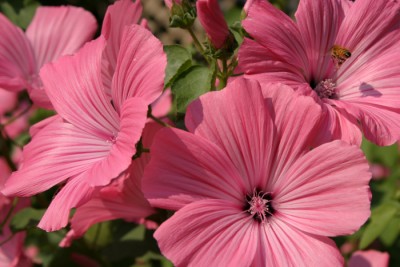 For the last few years I’ve been buying ground coffee and using a Cafetiere (AKA French Press) to make reasonable tasting coffee at home. The result is certainly better than filter coffee, and usually above the taste of most coffee you can buy while out and about. One of the downsides of this approach however is that you are relying on the coffee shop staff to be competent at their jobs. The only way to ensure you get coarse ground coffee put through the non-flavoured coffee grinder is to watch them like a hawk and be ready to speak up when they get it wrong.
For the last few years I’ve been buying ground coffee and using a Cafetiere (AKA French Press) to make reasonable tasting coffee at home. The result is certainly better than filter coffee, and usually above the taste of most coffee you can buy while out and about. One of the downsides of this approach however is that you are relying on the coffee shop staff to be competent at their jobs. The only way to ensure you get coarse ground coffee put through the non-flavoured coffee grinder is to watch them like a hawk and be ready to speak up when they get it wrong.
As my first step on the ladder of coffee obsessiveness I received a Rancilio Rocky for Christmas this year. Although the grinder turned up a week and half ago it is only this weekend that I went out of my way to get some good coffee beans to go with it. Following recommendations from a suppliers in the UK site I went into town to visit H. R Higgins (Coffee-man) Ltd.
The selection of available beans is impressive, almost to the point of being overwhelming. Several varieties were pointed out as being likely to appeal given my criteria, and of them I chose the Kibo Chagga. Although my taste buds are currently dulled by a cold, I have still been very impressed with my choice. Freshly ground Kibo Chagga made in a Cafetiere produces a very fine cup of coffee indeed. When I next need to get some more beans I’ll have a dilemma, do I go with something that I know is very good, or explore the alternatives in search of something that might be even better?
Remember summer? The season with warmth and flowers lives on in photographs from our holiday to Nova Scotia. The weather this weekend has been grey, although with no rain. Maybe next week I’ll grab the camera and take some of the sights of London.
January 30th, 2005
Living in London
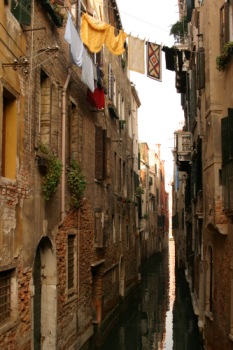 The last few weeks have been full of the tribulations of moving. In the end I saw a few more places before choosing somewhere, opting for a place in Limehouse. Since then I’ve been setting the flat up: getting food, phone, broadband (yay!), a wireless modem/router and lots of other bits-and-bobs that you need to live comfortably. Despite being fully furnished there has been an endless list of things for me to procure, ranging from wooden spoons to a pad of paper by the phone.
The last few weeks have been full of the tribulations of moving. In the end I saw a few more places before choosing somewhere, opting for a place in Limehouse. Since then I’ve been setting the flat up: getting food, phone, broadband (yay!), a wireless modem/router and lots of other bits-and-bobs that you need to live comfortably. Despite being fully furnished there has been an endless list of things for me to procure, ranging from wooden spoons to a pad of paper by the phone.
Now that I’ve got a good Internet connection again I’m hoping to clear my backlog of email and dedicate more time to keeping in touch with people. If anyone reading this is interested in meeting up in London let me know – my evening and weekends are going to be mostly free.
I’m not sure what to do in order to get a better way of judging colour in my photographs. The laptop screen is so different from sRGB that I know I’m not seeing my pictures as they should be seen. I’m reluctant to buy a CRT monitor though as it rather defeats the point of having a nice portable laptop! For now I’ll just have to take the opportunity to view pictures at work to ensure that the colours aren’t too far off.
Photo: Laundry left to dry in Venice (in the middle of winter!).
January 12th, 2005
The great flat hunt
After much delay, due to the Christmas period, I am finally deep in the process of finding somewhere to live in London. Shana is safely back in Toronto, and I’ve spent the last two days walking, viewing and negotiating. Day one wasn’t a success. The next paragraph was written in somewhat of a foul mood yesterday, but is still sadly accurate.
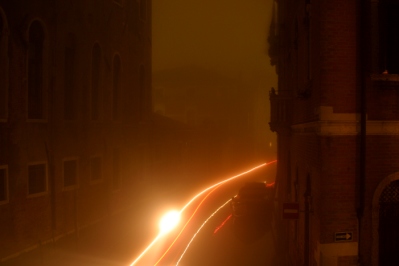 The London property market is depressing. The cost of accommodation is high, and more importantly the quality is extremely low. Take West Hampstead. A thriving, green, fun neighbourhood with many houses converted into flats. For £300 per week (that’s just shy of C$3000 per month for the Canadian residents among you) you would expect that landlords would have enough spare cash to spruce up the flats that they let. Certainly a quick clean of carpets, walls and windows couldn’t put them back too much. Unfortunately most of the properties I’ve seen in West Hamsptead at this price point are in urgent need of redecoration, never mind a good clean.
The London property market is depressing. The cost of accommodation is high, and more importantly the quality is extremely low. Take West Hampstead. A thriving, green, fun neighbourhood with many houses converted into flats. For £300 per week (that’s just shy of C$3000 per month for the Canadian residents among you) you would expect that landlords would have enough spare cash to spruce up the flats that they let. Certainly a quick clean of carpets, walls and windows couldn’t put them back too much. Unfortunately most of the properties I’ve seen in West Hamsptead at this price point are in urgent need of redecoration, never mind a good clean.
A converted house isn’t a two flat setup. A converted house will hold between 3 and 10 flats, all of them accessible off a narrow, winding, creaking stair case. The front door, entry corridor and stair case are all common areas (flats are owned by several individuals), and are subsequently poorly maintained.
Another way to look at the situation would be to write a West Hampstead style advert for our flat in Toronto. It would run something like “Sumptuous, enormous, superbly maintained, really-really big (no really, we mean it), well decorated, clean, big, large, spacious, you really could fit a family of five in here, split level, fabulous, centrally located flat with AIR CONDITIONING!!!”.
Day two, thankfully, showed more promise. I saw eight different flats in West Hampstead in the first day and of these only one was worth considering. The second day therefore was spent in a different neighbourhood. My initial experience of the docklands had persuaded me that I wouldn’t like to live there. There are very few local shops, and it’s hard to see how any kind of community could develop in such an environment. However, the Docklands have one major factor in its favour, and that is age. Unlike hacked up Victorian houses, the flats built in the Docklands were designed as flats from the beginning. They seem to almost always feature guest bathrooms, kitchens and bathrooms floors are always hard surfaces, and many have wooden floors through-out.
Unfortunately the Docklands isn’t restricted to high quality flats pitched at professionals. There’s also still a fair amount of poor housing stock in the area. As a result approximately half of the places I saw where inside gated communities, with a shockingly large difference in housing quality between the properties inside the gate and on the outside.
So far I’ve found two flats that would work for me. The first has views over the river, is close to Limehouse DLR, but is very close to a main road and has nothing really surrounding it. The second option is a completely new building, also rather closer to a main road than I would like, but close to something resembling a neighbourhood.
Tomorrow is probably decision time, and it’s not an easy call to make.
In Venice we had a couple of nights of dense fog. I’ve got a couple of good shots of a boat passing along the foggy canals, of which this one is rather abstract. I’m now using a laptop as my computer, so I’m not sure whether the colours and brightness are OK. Once I get a chance to view this photo on a CRT I may have to repost it.
December 27th, 2004
Moving to London
As many of my readers will already know, my job situation is resolved. I will be rejoining Amdocs in the UK, based in London. The role is a new one for me, and should allow me to build on my existing project management skills.
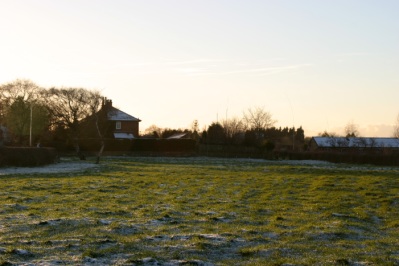 Moving to London entails finding somewhere to live, a task that will start in earnest in the second week of January. Ideally I will find a spacious two bed room flat on a quiet road within a good neighbourhood that is inside zone one or two. I’ve received some advice on places to look that are likely to be within my price range. Muswell Hill looks promising, if further out from the centre than I had hoped for. Islington is another option but seems to be rather more pricey.
Moving to London entails finding somewhere to live, a task that will start in earnest in the second week of January. Ideally I will find a spacious two bed room flat on a quiet road within a good neighbourhood that is inside zone one or two. I’ve received some advice on places to look that are likely to be within my price range. Muswell Hill looks promising, if further out from the centre than I had hoped for. Islington is another option but seems to be rather more pricey.
Hopefully I won’t have to spend more than a few days looking, before I find something that I like. If I haven’t found a property to rent within a week of looking I will have to be more flexible in my criteria.
Tomorrow we are going to York to meet up with old friends. It’s been too long since we’ve last seen everyone, something that will hopefully not recur now that we are once again based in the UK.
We had a white Christmas this year, the first for many years. On boxing day we went for a walk, and there were still remnants of snow left in the fields.
December 15th, 2004
Integrating ElementTree and SimpleTAL
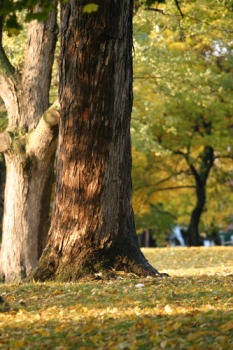 There has been a lot of talk recently about whether TAL could be integrated with XPATH, sparked it seems from Leslie Orchard‘s ideas on the subject. Replacing or augmenting TALES with XPATH wouldn’t provide as rich a transformation capability as XSLT, but it would be far simpler to understand and use. Providing XPATH support in SimpleTAL would require integrating with something like libxml2. I’m not sure whether there’s a way to customise the node instances that libxml2 returns, a prerequisite for integrating with SimpleTAL easily.
There has been a lot of talk recently about whether TAL could be integrated with XPATH, sparked it seems from Leslie Orchard‘s ideas on the subject. Replacing or augmenting TALES with XPATH wouldn’t provide as rich a transformation capability as XSLT, but it would be far simpler to understand and use. Providing XPATH support in SimpleTAL would require integrating with something like libxml2. I’m not sure whether there’s a way to customise the node instances that libxml2 returns, a prerequisite for integrating with SimpleTAL easily.
The ElementTree library provides a simplified way of accessing XML that, while not a full XPATH implementation, can still be useful. It also provides a simple mechanism by which customised Element instances can be produced, so integrating it with SimpleTAL is straight forward.
I’ve put together a basic integration, and released it as an experimental build for people to test and play with. If the integration doesn’t break anything, and is found to be useful, I’ll document and ship this as part of SimpleTAL.
The integration allows XML documents to be placed in the SimpleTAL Context. Using the new simpleElementTree module’s parseFile method creates a new object that is a subclass of both simpleTALES.ContextVariable and ElementTree._ElementInterface.
The syntax available when using this object from TAL consists of four options:
- element/find/SEARCHPATH
- element/findall/SEARCHPATH
- element/@ATTNAME
- element/SEARCHPATH
The last form is just short-hand for the first and can be used for anything where the SEARCHPATH does not start with either ‘find’ or ‘findall’ as an element name. The use of the /@ATTNAME can be combined with the first and last forms, i.e. book/find/author/@birthday is a valid path to use. The SEARCHPATH can be any valid ElementTree search path. To find an element ‘author’ that is directly under the ‘book’ element use a path of ‘book/author’. To find the element ‘author’ anywhere in the ‘book’ hierarchy use ‘book/.//author’.
The biggest piece of missing functionality with this integration is the ability to copy whole element structures into the target document. For example if the XML document you are working with contains <p>I am over <b>here</b>, not over there.</p> there is no way to extract all of this as a unit and include it into the target template. If ElementTree provided this facility it would probably be very simple to add to the implementation.
If this integration interests you, please take the time to download the experimental build, and test it out. There’s a small example included that should be a good starting point for exploring this functionality.
The picture is a reminder of the pleasant Autumn we had this year not, unfortunately, a reflection of the current weather.
Software
The full list of my published Software
Email: colin at owlfish.com
